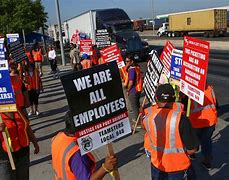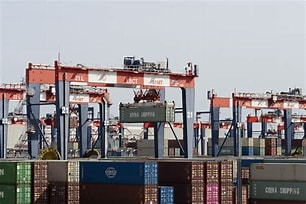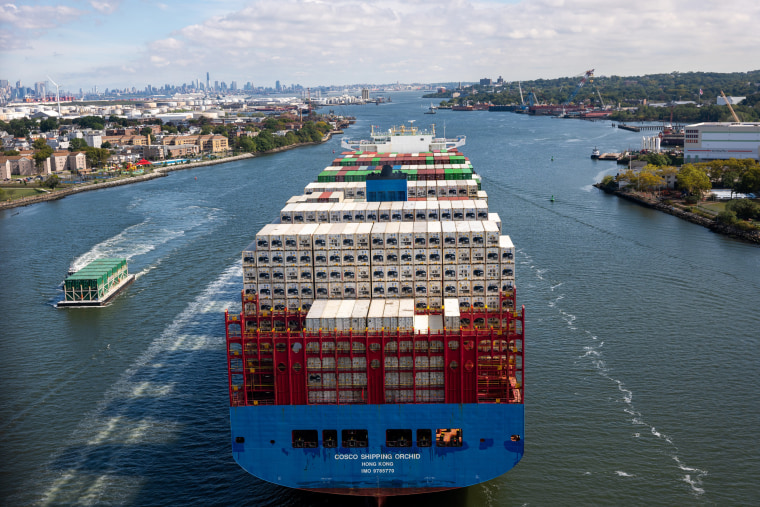Massive Port Strikes in The US 2024: Background, Workers’ Demands, and Government Reaction
Massive Port Strikes in the US in 2024, is not a new phenomenon. The U.S. has witnessed several significant port strikes over the years, each with profound economic and social implications. These strikes have often disrupted the global supply chain, delayed goods delivery, and exerted pressure on the government, businesses, and consumers. One of the most recent instances of massive port strikes brought the nation’s key maritime gateways to a standstill, creating ripple effects across industries that rely on imports and exports.

Background: Key Ports and Workers Involved
Port strikes typically occur in major U.S. port cities, particularly on the West Coast, where ports like Los Angeles, Long Beach, and Oakland serve as critical hubs for international trade. These ports handle a substantial volume of Asian imports, making them integral to the global supply chain. On the East Coast, the ports of New York and New Jersey, along with Gulf Coast ports like Houston, are also crucial trade points.
The workers involved in these strikes are primarily members of unions like the International Longshore and Warehouse Union (ILWU) and the International Longshoremen’s Association (ILA), which represent dockworkers responsible for loading and unloading cargo from ships, maintaining port equipment, and overseeing logistics. These workers form the backbone of the shipping industry and wield significant bargaining power due to the essential nature of their jobs.
The Root Causes and History of Port Strikes in The US
Port strikes are usually the culmination of long-standing grievances between port workers, their employers (often represented by port management companies), and sometimes even government agencies. Historically, the main causes for strikes have included:
Wage Disputes: One of the primary reasons for port strikes has been disagreements over wages. Union workers argue that the wages and benefits offered by port operators do not adequately reflect the work’s dangerous and physically demanding nature. These disputes often escalate when contracts expire and negotiations over wage increases stall.
Automation Concerns: With advancements in technology, automation has become a contentious issue in the shipping industry. Port operators have sought to increase the use of automated machinery, such as cranes and automated container handling systems, to improve efficiency and reduce costs. However, unions argue that automation threatens jobs and that port workers deserve a say in how new technologies are implemented.
Safety and Working Conditions: Port workers also advocate for safer working environments. Handling heavy containers and machinery in unpredictable weather conditions can be hazardous, and workers push for better safety standards and protocols to protect their health and well-being.
Healthcare and Retirement Benefits: Longshore workers often demand improved healthcare benefits, pensions, and retirement plans. Ensuring that these benefits keep pace with inflation and rising healthcare costs has been a key sticking point in labour negotiations.
Workers’ Demands: A Call for Fair Treatment
During massive port strikes, unions typically present a unified list of demands aimed at securing better working conditions for their members.
These demands often include:
Wage Increases: Workers seek wage hikes that reflect the cost of living and the growing profitability of the shipping industry. They also demand compensation for working overtime or in hazardous conditions.
Job Security: Unions call for assurances that workers’ jobs will not be eliminated by automation. They argue for the creation of joint labour-management committees to oversee the introduction of new technologies, ensuring that automation doesn’t come at the cost of significant job losses.
Improved Benefits: Workers demand better health insurance plans, including dental, vision, and disability coverage. Retirement benefits, including pensions, are also a critical part of negotiations.
Safer Work Environments: Unions often push for more stringent safety protocols to reduce workplace injuries and fatalities. This includes improved training programs and updated safety equipment.
Economic Impact of the Strikes
Port strikes have a profound impact on both the U.S. and global economies. When longshore workers stop working, it disrupts the movement of goods across borders, leading to delays in shipments, increased shipping costs, and shortages of consumer goods. During major port strikes, industries that depend on imported materials—such as manufacturing, retail, and agriculture—can experience significant setbacks.
For example, the 2014-2015 West Coast port strike caused a severe slowdown in cargo handling, costing the U.S. economy an estimated $2 billion per day. Retailers struggled to keep shelves stocked, manufacturers faced production delays, and perishable goods like fruits and vegetables went to waste. Furthermore, international trade partners, particularly in Asia, were forced to reroute shipments to avoid the disruption, further complicating global logistics.
Government Reaction: Mediation and Intervention
In response to port strikes, the U.S. government typically adopts a measured approach, often acting as a mediator between unions and port management. However, when strikes threaten to cripple the national economy or create widespread shortages, the government may intervene more aggressively.
Mediation and Negotiations: The Federal Mediation and Conciliation Service (FMCS) often steps in to facilitate negotiations between port workers and management. Mediators work to find common ground and resolve disputes without escalating the situation into prolonged strikes. In some cases, state and local governments also get involved to ease tensions.
Invoking the Taft-Hartley Act: In extreme cases, the government has the authority to invoke the Taft-Hartley Act, which allows the President to order workers back to their jobs for an 80-day “cooling-off” period while negotiations continue. This was last used during a major port strike in 2002 when West Coast ports were shut down for ten days, costing the economy billions. Although it is rarely invoked, the possibility of using the Taft-Hartley Act looms large in significant labour disputes.
Addressing Broader Economic Impacts: Government officials also focus on the broader economic consequences of port strikes. They may coordinate with other industries to minimize supply chain disruptions and look for ways to mitigate the impact on consumers and businesses, including rerouting goods through other ports or encouraging diplomatic interventions with trading partners.
The Path Forward: The Future of U.S. Ports and Labor Relations
As global trade continues to expand and the demand for faster shipping intensifies, the tensions between labour and management in U.S. ports are unlikely to dissipate. The push for automation, in particular, will remain a focal point of contention in labour negotiations. Moving forward, the ability of unions, port operators, and the government to work together and find mutually beneficial solutions will be key to preventing further strikes.
Strengthening dialogue, addressing workers’ concerns about automation and safety, and ensuring fair wages and benefits will be crucial in maintaining the smooth operation of the U.S. port system and safeguarding the country’s position in the global economy.
The ongoing port strikes in the U.S., particularly along the East Coast and Gulf regions, have sparked concerns about shortages of essential items. States such as New York, New Jersey, and Texas are already seeing consumers stock up on groceries and household products. Experts predict price hikes on food, personal care items, and other everyday goods due to supply chain disruptions. The fear is particularly strong for essentials like toilet paper and groceries, with some shoppers preparing for potential shortages reminiscent of earlier crises.
The U.S. government is considering several options to address the potential long-term effects of the ongoing port strikes on the East and Gulf coasts. However, there are limitations on how it can intervene. Historically, one major tool the government has used is the Taft-Hartley Act, which allows the President to impose an 80-day cooling-off period if the strike threatens national health or safety. While President Biden may consider this option, his administration is cautious due to his strong pro-labor stance and the upcoming presidential election. Any direct intervention could impact his relationship with unions, which are key political supporters.
In the meantime, government officials are urging both sides to return to the negotiating table. They have not yet invoked Taft-Hartley, as ILA leadership has explicitly stated they prefer independent negotiations without government interference. In the event of a prolonged strike, there may be further pressure for intervention, especially as the strikes disrupt supply chains, increase prices, and potentially affect the economy during the critical holiday retail season.
Additionally, logistical alternatives like rerouting goods to other less-impacted ports or using rail and truck transport are being considered by industry stakeholders to mitigate immediate disruptions. However, if the strike continues, broader government actions, such as temporary legislation or more direct involvement in negotiations, might become necessary.
The port strikes are expected to have significant and immediate effects on retailers, especially as they coincide with the peak shopping season in the U.S., including the holiday period.
Here’s how the strikes could impact retailers:

A container ship left the Port of Newark, N.J., on Monday hours before a threatened strike halted operations.Spencer Platt / Getty Images
- Supply Chain Disruptions: Retailers rely heavily on timely deliveries of goods, especially during critical sales periods like Black Friday and Christmas. The strike will disrupt the flow of imported merchandise, causing delays. This could lead to inventory shortages of essential items like electronics, apparel, and holiday-specific products.
- Increased Costs: With cargo movement halted or delayed, shipping costs are likely to surge. This could force retailers to either absorb the higher costs or pass them on to consumers, resulting in price hikes. Such increases might lead to reduced consumer spending, particularly in the current economic climate, where inflation is already a concern.
- Inventory Shortages: Retailers using just-in-time inventory management systems could be especially vulnerable. Delayed shipments will impact their ability to stock shelves, leading to potential shortages of high-demand items. Retailers may also need to scramble to find alternative suppliers or reroute goods through less impacted ports, adding further complexity and delays.
- Holiday Sales Impact: The strike’s timing, just before the holiday season, is particularly challenging. Retailers often ramp up their inventory in preparation for holiday shopping, and any disruption during this period could severely impact their revenue. If goods don’t arrive on time, retailers may miss out on one of their most profitable times of the year.
In summary, the ongoing port strikes could lead to increased costs, inventory shortages, and significant disruptions to the retail sector, especially during the holiday season when demand peaks.
President Biden’s approach to the ongoing port strikes is largely focused on facilitating negotiations rather than direct intervention. He is cautious about invoking the Taft-Hartley Act, which would force workers back to work for an 80-day cooling-off period, because of the political risks involved, especially given his strong pro-labour stance and the importance of union support ahead of the 2024 election. The White House is reportedly monitoring the situation closely, but Biden has so far favoured allowing the unions and port operators to negotiate independently.
Despite this, there is significant pressure on the administration to act if the strikes persist and cause major economic disruptions, especially for industries like retail and agriculture. Should the strike lead to severe supply chain bottlenecks, Biden may be forced to step in, either by urging both sides toward a settlement or by considering temporary actions like rerouting or logistical solutions to prevent shortages.
Ultimately, Biden’s strategy appears to be aimed at balancing the needs of the economy with his political commitment to unions, opting to wait before using stronger measures like the Taft-Hartley Act.
Conclusion
Massive port strikes in the U.S. are not just labour disputes; they have far-reaching economic and social consequences. Workers demand fair wages, job security, and safer working conditions, while the government seeks to balance labour rights with the need to keep trade flowing smoothly. As the shipping industry evolves, particularly with automation, the future of U.S. ports will depend on cooperation and compromise among all stakeholders involved.
If you enjoyed this article, please like and share it with your friends, and don’t forget to Share your personal experience/observations thoughts and valuable suggestions to share for the education /benefit of others. Do subscribe to remain onboard and get more great content!
US Election 2024: America’s Choice for President and New Begining